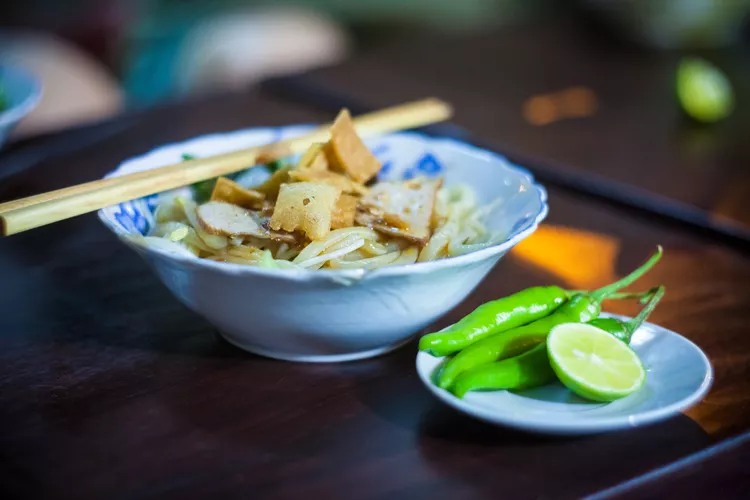1. Overview of Cao Lau
Explore the rich history of Cao Lau noodles, their unique preparation, and the significance of this dish in Hoi An.
2. Understanding Cao Lau Noodles
Learn about the distinct texture and serving style of Cao Lau compared to other Vietnamese noodle dishes.
3. The Secret Behind Cao Lau
Find out what makes authentic Cao Lau special and why it cannot be replicated elsewhere in Vietnam.
4. Where to Find Authentic Cao Lau
Discover the best places in Hoi An to enjoy genuine Cao Lau noodles.
5. Eating Cao Lau in Hoi An
Understand the traditional ways of enjoying Cao Lau and what to expect when you dig in.
6. Other Must-Try Specialties in Hoi An
Explore other local culinary delights you shouldn’t miss while visiting.
The History, Ingredients, Preparation, and Where to Find This Signature Dish
The historic trading town of Hoi An in Central Vietnam is a popular stop for tourists on the Saigon-Hanoi trail. Dutch, Chinese, Japanese, and Indian traders came to Hoi An to conduct business and exchange goods until the 17th century. While waiting for their ships to be unloaded, the traders would rest on the second floor of a riverfront restaurant with a view and enjoy a steaming bowl of Cao Lau noodles.
Trading and shipping have long since moved north to Da Nang; however, Cao Lau remains a source of pride for locals in Hoi An. The unique noodle dish can only be made in Hoi An.
Cao Lau Noodles
One of the most remarkable characteristics of Cao Lau is its texture. The noodles are firmer and chewier, resembling Japanese udon, in contrast to the softer noodles found in typical Vietnamese dishes like pho.
Unlike traditional pho, Cao Lau features minimal broth. The broth is seasoned with cilantro, basil, and mint; sometimes chili peppers and lime are served on the side. Cao Lau is traditionally served with salad greens and bean sprouts, although many eateries may omit these vital components to save costs. Unless requested vegetarian, thinly sliced pork and deep-fried croutons are added to complete the dish.
The Secret of Cao Lau
Why can’t Cao Lau be replicated outside of Vietnam? The ultimate secret is in the water; authentic Cao Lau is prepared only with water drawn from ancient Cham wells located around Hoi An and Quang Nam Province. The noodles are pre-soaked in well water and lye made from wood ash sourced from one of the eight Cham Islands approximately 10 miles from Hoi An. Although it may sound complex, local enthusiasts can discern a notable difference in both taste and texture!
Finding Authentic Cao Lau in Hoi An
Cao Lau can be found on nearly every menu in Hoi An, both in the Old Town and in the bustling streets outside. With numerous establishments presenting their version of the dish, finding true authentic Cao Lau can be challenging. Some restaurants may skip key ingredients or fail to use well water; others may even try to pass off pho broth as a shortcut!
True Cao Lau requires a lengthy preparation process. In fact, many Hoi An locals prefer dining out for this specialty, leaving the preparation to seasoned experts.
The best approach to discover genuine Cao Lau in Hoi An is to seek out street vendors that specialize exclusively in this dish or offer a limited selection of local fare. Don’t expect the true experience at tourist-centric restaurants with extensive menus.
If you’re willing to embrace the vibrant atmosphere, authentic Cao Lau can be acquired from stalls in the outdoor market on the east end of Bach Dang Street along the river. Alternatively, consider visiting a restaurant that operates a cooking school; many students prepare authentic Cao Lau as part of their culinary training.
Eating Cao Lau
Despite the labor-intensive preparation, Cao Lau is affordably priced—usually under $2 a bowl. While this dish is available in most eateries until late at night, locals favor enjoying it for breakfast or lunch to allow ample time for digestion of the hearty noodles.
Traditionally, the most authentic way to relish Cao Lau is by dining on the second floor of a restaurant, emulating the experience of ancient traders. Although the altitude does not affect the delicious flavor, savoring the same view over the river while indulging in this historical taste can be incredibly satisfying!
Other Hoi An Specialties
White Rose: Cao Lau isn’t the only treat to relish in Hoi An. White Rose—an appetizer named for its presentation—features delicate noodle dumplings with ingredients like shrimp and pork positioned atop the folded noodles rather than stuffed inside.
Hoi An Pancakes: Distinct from Western-style pancakes, Hoi An pancakes are prevalent in local menus. Often described as “country-style pancakes,” this appetizer is an interactive dish consisting of an egg omelet filled with vegetables, complemented by a bowl of water, a plate of salad greens, mint leaves, and several sheets of hard rice paper that closely resemble plastic!
To enjoy Hoi An pancakes, quickly dip the rice paper in water to make it soft and pliable. Then, engage in the delicate art of rolling the omelet and greens within the sticky paper to create a delicious pancake reminiscent of a thick spring roll. Hopefully, the staff will lend a helping hand to guide you through the process!
Fresh Beer: The locally brewed beer in Hoi An is perfect for washing down your bowl of Cao Lau noodles. Although restaurants do not produce this beer themselves, it is sourced daily from local brewers and needs to be consumed within 24 hours. Often referred to as “fresh beer” on signs and menus, a tall glass of this Pilsner typically costs 25 cents or less!





